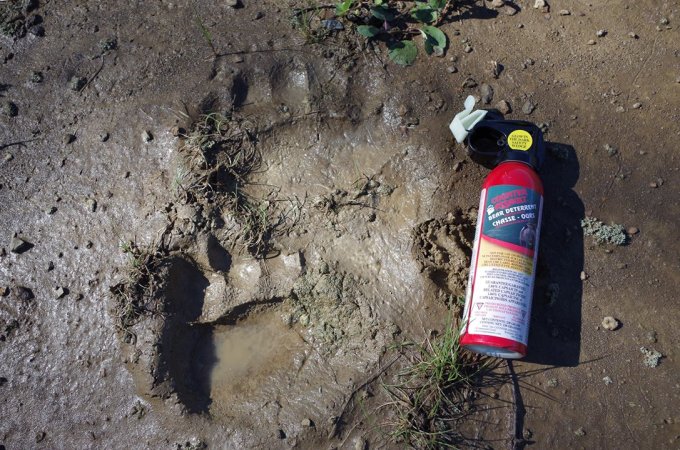Firefighter in the Field: The Role of Lookouts in Observing and Monitoring Forest Health

By: Trina
The idea of living in the boreal forest at a fly-in fire tower for five months is unfathomable for many people – and rightfully so. As a rookie lookout observer, I wasn’t sure what to expect last April when I nervously loaded up my boxes of food and belongings into the helicopter. Was I bringing the right things? How would I handle the long days of solitude?

“I would get so bored out there,” some people comment. “What did you do for so many days?” Others ask, point blank, “How did you keep from going crazy?”
I could answer the questions by spouting off a long list of the various things I did in my down-time, like planting carrots and sunflowers, reading novels, writing, painting aerial art on my picnic table, plucking away at a ukulele, or hiking with my loyal, four-legged friend, Holly. It’s also true that the tasks of daily living, including sweeping and scrubbing the cabin, washing clothes by hand, hauling rainwater, and cooking meals to get me through the long afternoons spent up in the cupola, filled up my time at the tower.

But the real truth is that I spent most of the summer – 135 days, to be exact – doing absolutely nothing but watching a 50 kilometer radius of land, and scanning the horizon and treetops for smoke. With record high levels of precipitation in the Peace Country this past summer, the forests were saturated with moisture, and as a result, I wouldn’t end up seeing, or reporting many smokes. But nearly everyday, I saw and learned something interesting from my forest surroundings.
As the days unfolded, I realized my ability to witness what wild things grew, roamed, crawled, and flew around me, had sharpened into a much clearer focus. I was privy to sit back and watch the subtle, incremental processes that unfold in the boreal forest from spring to summer to fall.

In May, I observed the slightest changes in the trees as their brown stick limbs bore green leaves, and a plethora of pollinators arrived around my cabin, buzzing from tiny white wild strawberry flowers to the fat, furry dandelion heads. I’ll never forget the day I spotted a flock of trumpeter swans flying north of my tower. As they flew in and out of their V-flock formation, they appeared atop the black spruce like a delicate white scarf. Their migratory arrival from the southwest signified that spring had come.
Noticing these things – the arrival of birds, mammals, insects and pollinators, and the corresponding changes in the trees and grasses – is all a part of a lookout’s job portfolio. From spring to autumn, we are responsible for reporting what forestry calls the “Green Up Stages”. We try to specify the exact dates of when the sticky buds open on the aspen trees, or when the coniferous needles flush out of their tight cones. We watch and record when the colour pallet of the trees and grasses change from brown to green to shades of yellow and red. This information about the forest is vital to predicting fire risk and behavior. It’s also essential to understanding and monitoring the impact of weather and climate, along with other pressures, on the long-term health of the forest.

Into June and July, I learned many of the names of the indigenous plants, wildflowers, and berries that sprung up around my tower: yarrow, horsetail, arnica, bilberries (dwarf blueberries), dewberries, and cloudberries. I kept track of the days they budded, produced berries, ripened, and let their seeds fly for next summer’s bounty.
“Everything has come early this year,” commented Ralph, a veteran lookout to my southwest, referring to the unusually early blossoming of the Alberta wild rose flowers. Having worked as a lookout for thirty years, Ralph has a wealth of experience and knowledge in plant health and processes in the boreal forest. Take what I witnessed and learned about the forest in a single season and multiple that by thirty years. Lookouts possess a deep, rich understanding of the landscapes they live and look out on. The knowledge of veteran lookouts like Ralph is, truly, invaluable.

Alberta Forestry has also tapped into the experiential knowledge of lookout observers. Over the years, lookouts have collected data for various studies and research projects on plants, insects, birds, and mammals.
In the Peace River District, lookouts have been participating in a study to better understand the flight periods of Mountain Pine Beetles. Pine beetles are native to the boreal, but their numbers have proliferated in both British Columbia and Alberta over the past decade, causing significant loss and damage to the timber industries. Forestry health officers set up monitoring traps at fire towers, and enlisted the support of lookouts to collect data on pine beetle’s flight behaviors.
“Lookouts’ contributions to our research has been both significant and meaningful,” says Ryan Hermanutz, a Forestry Health Officer in Peace River. “The monitoring of flight periods has increased our understanding of the beetle’s biology and how we can manage these forest insects commonly referred to as ‘pests’.”

While I didn’t participate in the pine beetle study this past summer, I would eventually come face-to-face with another, let’s say, ‘unexpected’ research opportunity.
On Canada Day, I descended my tower at 7 o’clock, threw off my climbing harness, and set out on a walk with my dog, Holly. As we strolled down a familiar trail and rounded the corner into a grassy clearing, I stopped dead in my tracks. I noticed an unfamiliar shape, humped like a golden haystack, in the sweet clover patch, only 100 meters away. As the sunlight caught the hairs of the creature – glinting brownish-silver – I was startled to realize it was a grizzly bear.
I had seen several black bears at my tower, but I wasn’t expecting to see the more rarely spotted grizzly, a threatened species in Alberta. I looked down at Holly, grabbed her collar, and slowly backed off, retracing my steps to the cabin.

From the safety of the tower, I watched the grizzly bear grazing in the clover before sauntering into the bush and disappearing from sight. The sheer size of the creature – much bigger than any black bear I’d seen that summer – made my hairs stand on end.
The sighting prompted me to reach out to Lyle Fullerton and Courtney Hughes, biologists in the Peace Country who are currently conducting the first-ever population study of grizzly bears in the Chinchaga region. Fullerton responded to my email with: “Can you get a scat sample?”
The following day, I cautiously walked back to the clearing, took photographs of the grizzly tracks, and collected a bit of bear scat. A few days later, I handed the scat sample off to forestry staff, and away it flew in a helicopter to reach Lyle and Courtney’s research team in Peace River, where it would then be sent to the labs for DNA analysis.

It was a very memorable Canada Day, indeed.
When I reflect back on my first season as a lookout, I would be lying if I said that boredom never found me, or there wasn’t a day that I became frustrated with such intense isolation. But when I think about my encounter with the grizzly bear, or pure beauty of witnessing the flight of the trumpeter swans, I realize that being a lookout is a unique and privileged thing.
It was amazing to have the opportunity to learn on a daily, even hourly basis, to contribute to important forest health research, and to know that I could never really anticipate, or control what would happen next. Such was my summer in the boreal forest.

Leave a comment